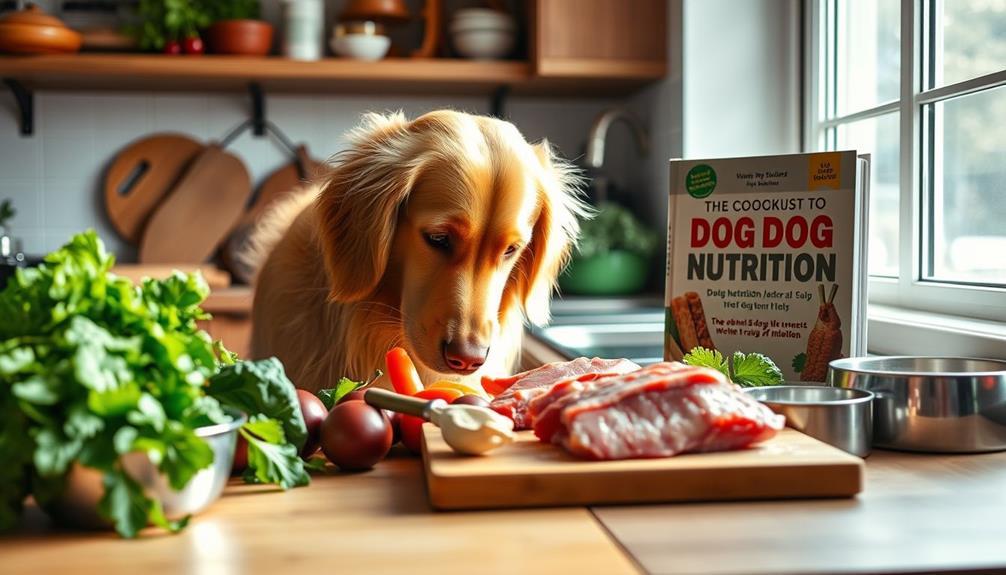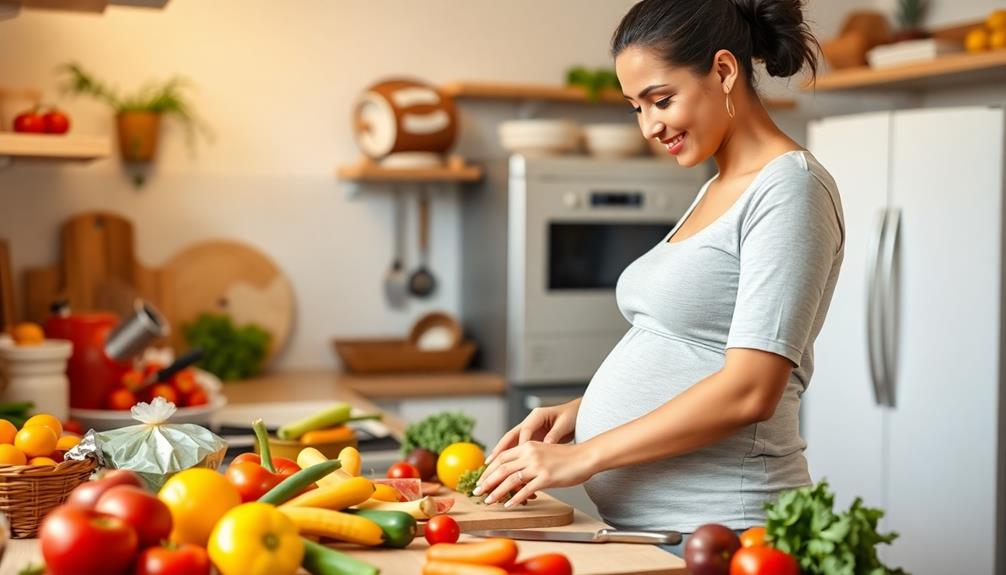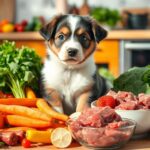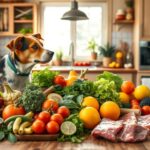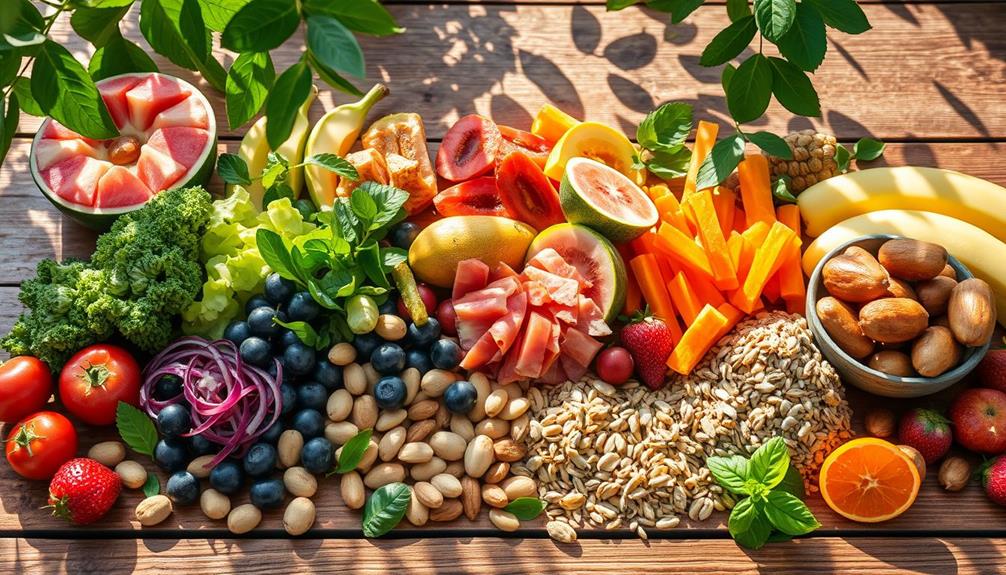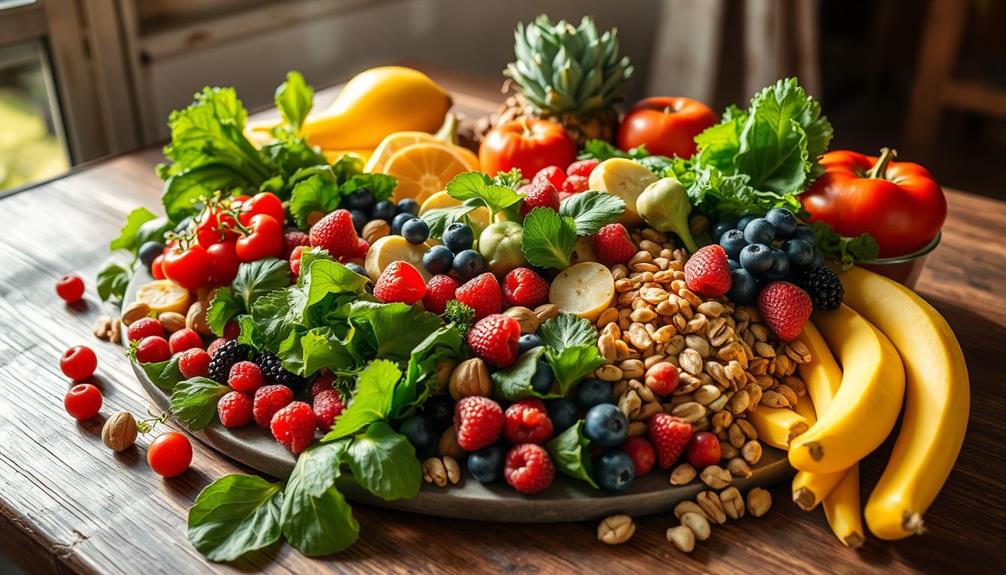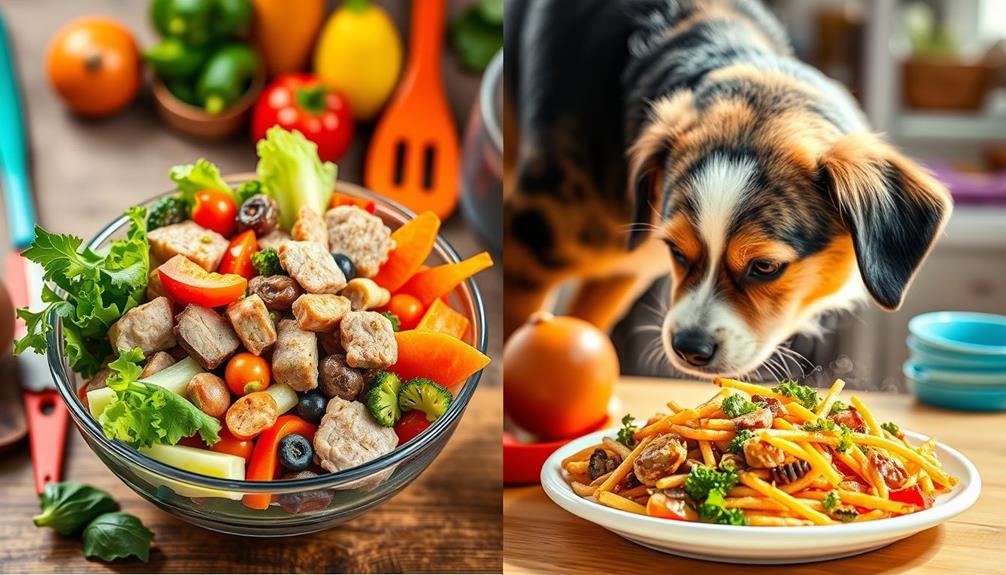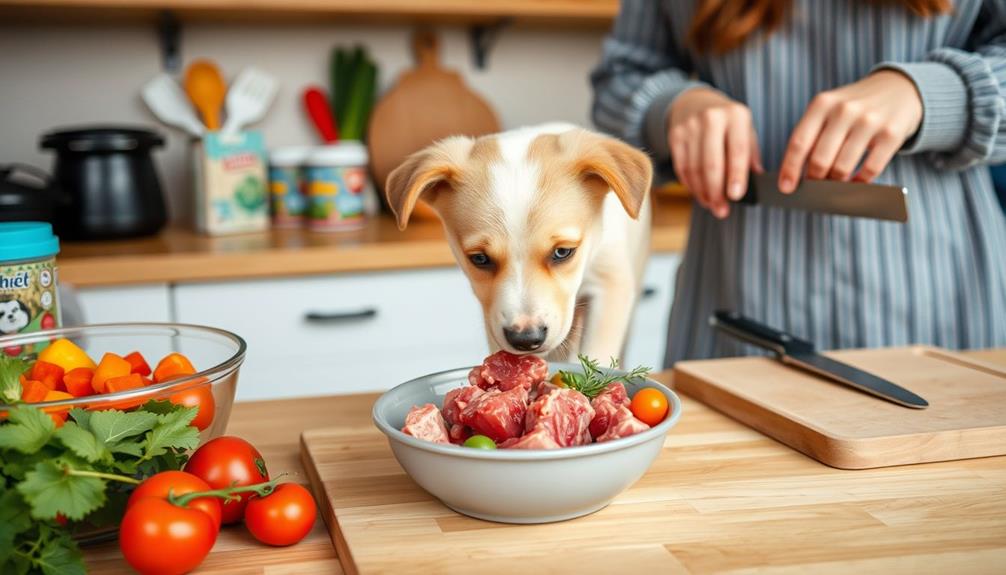Raw food diets can indeed offer benefits for your dog, like shinier coats and cleaner teeth, but they also come with serious risks. Many raw meat samples test positive for harmful bacteria, which can affect both your pet and your family. To guarantee safety, you need to handle and store raw food correctly, keeping it separate from other foods and thoroughly washing your hands afterward. Consulting a veterinary nutritionist is essential for balanced nutrition, as improper raw diets may lead to deficiencies. You'll find even more insights and tips on how to navigate this feeding choice safely.
Key Takeaways
- Raw food diets can pose health risks, with a significant percentage testing positive for harmful bacteria like Salmonella and Listeria.
- Consultation with a veterinary nutritionist is essential to ensure a balanced diet and avoid nutritional deficiencies.
- Strict hygiene practices, such as washing hands and disinfecting surfaces, are crucial when handling raw food to prevent cross-contamination.
- Raw diets may improve energy levels and dental health, but they require careful planning to meet essential nutrient profiles.
- Vulnerable individuals should avoid raw diets at home due to the risk of bacterial transmission from pets.
Understanding Raw Food Diets
A raw food diet for dogs typically includes raw meat, bones, fruits, and vegetables, with its popularity rising since Ian Billinghurst introduced the BARF diet in 1993. As you consider feeding raw food, it's vital to understand what this entails. Many dog owners are opting for raw dog food, and sales of raw meat-based diets have grown remarkably—around 15% annually.
Advocates of raw diets tout benefits like shinier coats, cleaner teeth, improved energy levels, and smaller stool sizes, although scientific backing for these claims remains limited. Additionally, incorporating nutrient-rich foods can help address some potential deficiencies in a raw diet.
While the appeal of a raw diet is strong, you should be aware of potential nutritional deficiencies. Raw food diets may lack balanced macro- and micro-nutrients, so consulting a veterinary nutritionist for proper dietary planning is vital.
Additionally, handling raw food poses health risks, as studies indicate that around 25% of raw food samples can harbor harmful bacteria like Salmonella and Listeria monocytogenes. If you choose to provide commercially available raw dog food, verify it meets safety standards.
Ultimately, understanding the benefits and challenges of a raw diet will help you make an informed decision for your dog's health.
Health Risks Associated With Raw Diets
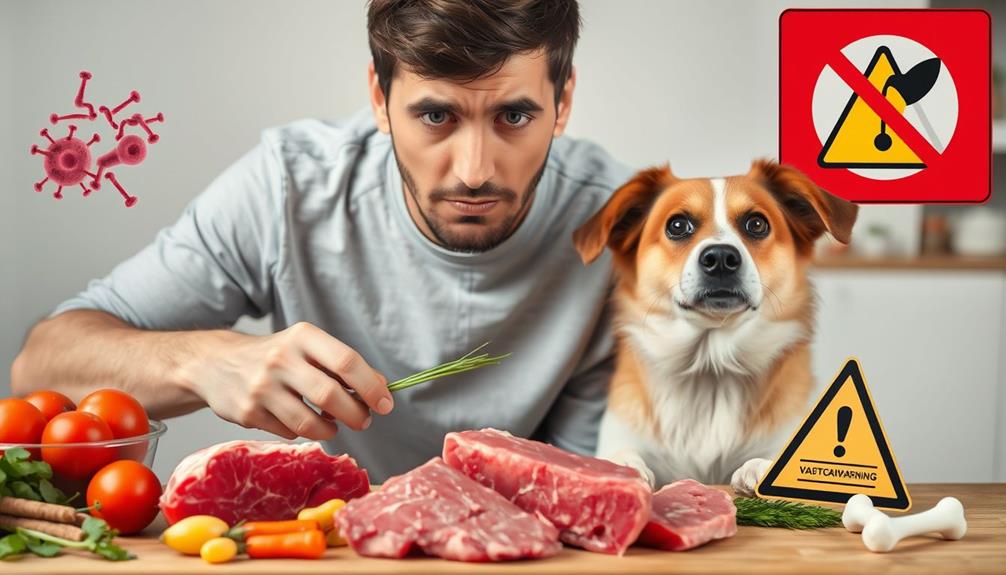
Health risks linked to raw diets for dogs are notable and shouldn't be overlooked. Studies reveal that about 25% of raw food samples test positive for harmful bacteria like Salmonella and Listeria monocytogenes. This poses a serious threat, as the CDC reports over 1.2 million cases of salmonellosis in the U.S. annually. Your dog could carry Salmonella without showing any symptoms, increasing the risk of transmission to you and your family.
Additionally, the potential for exposure to these pathogens underscores the necessity of cold medications overview for maintaining overall health during illness, as a compromised immune system could further amplify the risks. Listeriosis, caused by Listeria monocytogenes, is another concern, with around 1,600 cases and 260 deaths each year in the U.S., particularly affecting vulnerable groups like children and the elderly.
Proper handling of raw diets is vital. The CDC recommends washing hands and disinfecting surfaces after handling raw food to greatly reduce the risk of foodborne illness.
Due to these documented hazards, many veterinarians and animal care facilities refuse to accept pets on raw diets. They raise concerns not only about health risks but also about the challenge of ensuring balanced nutrition. Overall, it's important to weigh these risks carefully when considering a raw diet for your dog.
Nutritional Balance in Raw Feeding
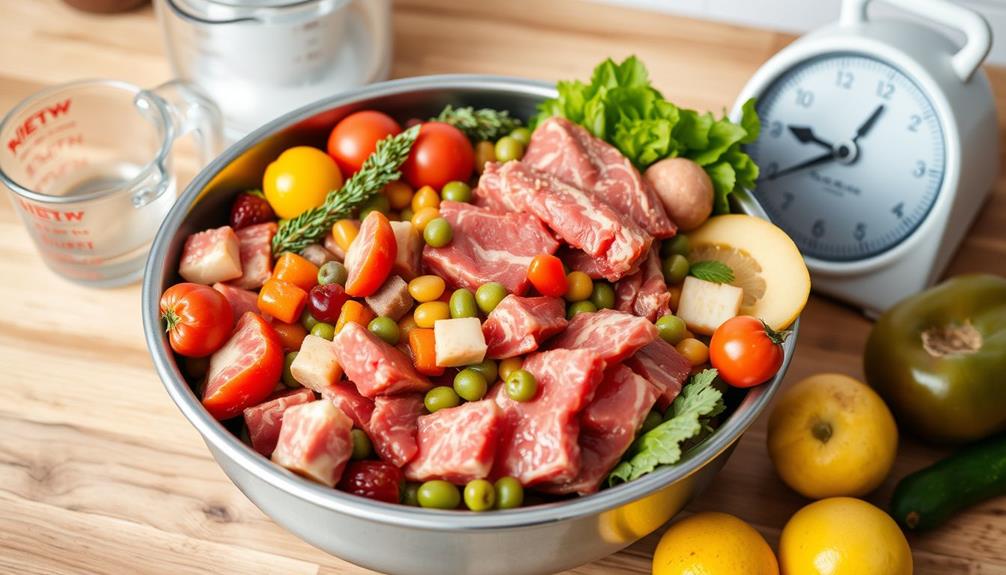
When considering a raw diet for your dog, ensuring essential nutritional components is vital to avoid potential deficiencies.
It's important to consult a veterinary nutritionist to create a balanced meal plan that meets your pet's needs.
Additionally, understanding the proper diet for pets can help guide you in selecting the right ingredients.
Without proper guidance, you risk not providing the nutrients your dog requires for ideal health.
Essential Nutritional Components
To guarantee your dog thrives on a raw food diet, it's important to include a well-balanced mix of proteins, fats, carbohydrates, vitamins, and minerals. These necessary nutritional components play a significant role in meeting your dog's nutritional needs and preventing deficiencies.
Incorporating healthy fats from sources like fish oil can also support your dog's skin and coat health, similar to how certain important oils can benefit overall wellness in pets, such as eucalyptus oil for respiratory health. A raw diet should primarily consist of high-quality proteins, such as lean meats and organ meats, which provide essential amino acids.
Don't forget about healthy fats, which are required for energy and skin health. Calcium and phosphorus are particularly significant, especially for growing puppies, as they help support proper skeletal development and prevent issues later in life.
Additionally, incorporating a variety of fruits and vegetables can supply necessary vitamins and antioxidants. However, many raw diets can lack these important macro- and micro-nutrients, so it's wise to consult with a veterinary nutritionist when planning your dog's raw feeding regimen.
Monitoring your pet for signs of nutrient deficiencies or gastrointestinal upset during the shift to a raw food diet is important. By making adjustments as needed, you can maintain a nutritional balance that supports your dog's overall health and well-being.
Potential Deficiencies Risks
Raw feeding can be a double-edged sword for your dog's nutrition. While many pet owners believe raw food diets offer health benefits, they can also lead to nutritional deficiencies if not carefully balanced.
It's important to understand the implications of improper diet management, especially considering the significance of financial considerations for elderly care when planning for long-term pet care. Many raw meat-based diets, especially those from smaller companies, often fail to meet AAFCO nutrient profiles, raising concerns about their overall adequacy.
Common deficiencies include inadequate levels of calcium and phosphorus, which are essential for bone health, particularly in growing puppies. If your homemade raw diets lack these crucial nutrients, you might notice health issues like anemia, weakened immune function, and poor dental health over time.
To avoid these pitfalls, it's imperative to seek guidance from a veterinary nutritionist. They can help guarantee that your dog's raw diet is balanced and meets their unique nutritional needs.
Without this expert input, you risk compromising your dog's health, which is the opposite of what you want. Remember, a well-structured raw diet can support your dog's immune system and overall well-being, but it requires careful planning and knowledge to achieve that balance.
Veterinary Consultation Importance
Consulting with a veterinary nutritionist can make all the difference when it comes to guaranteeing your dog's raw diet is nutritionally balanced. Many raw diets lack fundamental nutrients, potentially leading to severe health issues over time if they're not properly formulated.
By seeking professional guidance, you can address these concerns and avoid nutritional deficiencies that could adversely affect your dog's health. Additionally, being aware of common financial terms related to pet care can help you budget effectively for your dog's nutritional needs.
Veterinary professionals can provide tailored recommendations based on your dog's specific needs, including age, activity level, and any pre-existing medical conditions. This personalized approach helps create a raw diet that meets the balanced macro- and micro-nutrient requirements outlined by AAFCO.
Regular monitoring and ongoing consultations with your veterinarian are important when feeding a raw diet. This allows you to promptly address any gastrointestinal issues or nutritional deficiencies that may arise.
Bacterial Contamination Concerns
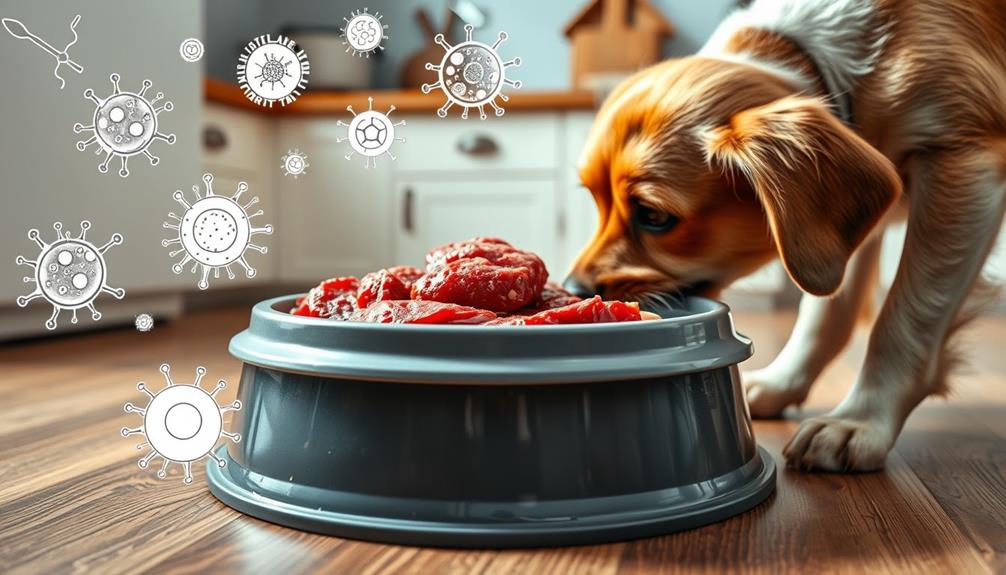
When it comes to raw dog food, bacterial contamination is a serious concern. You mightn't realize that pathogens like Salmonella and Listeria can pose risks not just to your dog but also to your family.
Regularly cleaning and monitoring the surfaces where raw food is prepared is essential to prevent cross-contamination. Additionally, ensuring proper airflow in your kitchen can help minimize the spread of bacteria, much like how maintaining an air purifier's efficiency is key to enhancing air quality air purifier maintenance tips.
Understanding these common bacteria and practicing safe handling methods can help keep everyone healthy.
Common Bacterial Pathogens
One in four raw food samples tested has been found to harbor harmful bacteria, raising significant concerns for dog owners. The most common culprits are Salmonella and Listeria, both of which can lead to serious food-borne illnesses. Regular handling of raw ingredients can introduce health risks not only to pets but also to humans, as some ice cream health considerations apply when it comes to food safety in general.
Salmonellosis, caused by Salmonella, results in over 1.2 million cases annually in the U.S. Symptoms in humans include fever and diarrhea, while dogs may experience vomiting and lethargy. Listeria monocytogenes poses another threat, responsible for about 1,600 human cases and approximately 260 deaths each year. Dogs can carry Listeria without showing symptoms, creating risks for everyone in the household.
These health risks associated with raw food diets extend beyond your pet. The FDA and CDC warn that bacterial contamination can affect you, too. As a pet owner, it's essential to understand that handling raw ingredients requires caution.
Implementing proper hygiene practices, such as washing your hands and disinfecting surfaces after handling raw food, can help mitigate these risks. Being aware of these common bacterial pathogens will empower you to make informed choices about your dog's diet and your family's safety.
Safe Handling Practices
Handling raw dog food safely is essential to prevent bacterial contamination that can harm both pets and humans. Raw dog food can harbor harmful bacteria like Salmonella and Listeria, which pose significant health risks. To minimize these risks, always keep raw food separate from other food items, just as proper hygiene is vital for piercing care and hygiene.
Store it in the freezer until you're ready to use it, and thaw it in the refrigerator or microwave.
When you're preparing to feed your dog a raw diet, make sure to wash your hands thoroughly with soap and water after handling the food. This is one of the most effective proper hygiene practices pet owners can adopt.
It's equally important to disinfect all surfaces and utensils that come in contact with raw food.
Avoid letting your pet kiss you around the mouth after consuming raw food, as this can increase the risk of bacteria transmission.
Veterinary Insights on Raw Diets
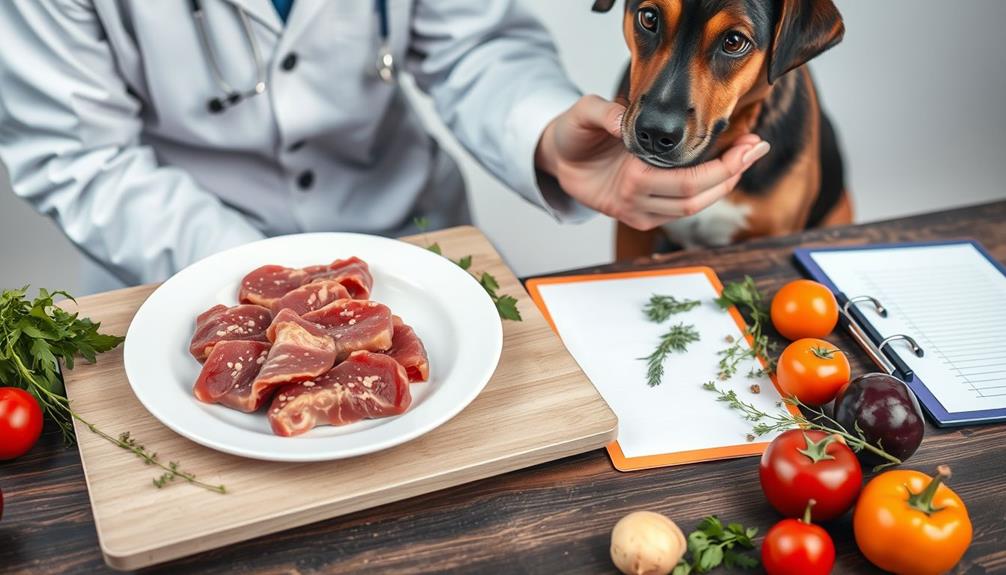
Veterinary professionals raise significant concerns about the safety and nutritional balance of raw diets for dogs. Many veterinarians highlight the health risks associated with bacteria in raw food, noting that studies show 25% of raw samples can contain harmful pathogens like Salmonella and Listeria monocytogenes.
This isn't just a pet problem; the CDC estimates over 1.2 million cases of salmonellosis occur annually in the US, affecting both pets and their owners. Additionally, the risks associated with raw diets can be likened to the importance of protecting your savings from potential scams; just as due diligence is necessary in finance, it's equally critical in guaranteeing the safety of your pet's diet.
Consider these emotional implications:
- Your beloved pet could be at risk of serious illness.
- Handling raw food may expose your family to harmful bacteria.
- The perceived benefits of raw diets mightn't outweigh the safety concerns.
Raw diets often lack balanced nutrition, leading veterinarians to recommend consulting with a veterinary nutritionist for proper dietary planning.
Many veterinary practices refuse to treat pets on raw diets due to these disease risks. While some owners report improved energy and coat health, there's no clinically proven advantage over commercial pet food, which is designed to guarantee balanced nutrition and food safety.
Always prioritize your pet's health and well-being when making dietary choices.
Safe Handling Practices
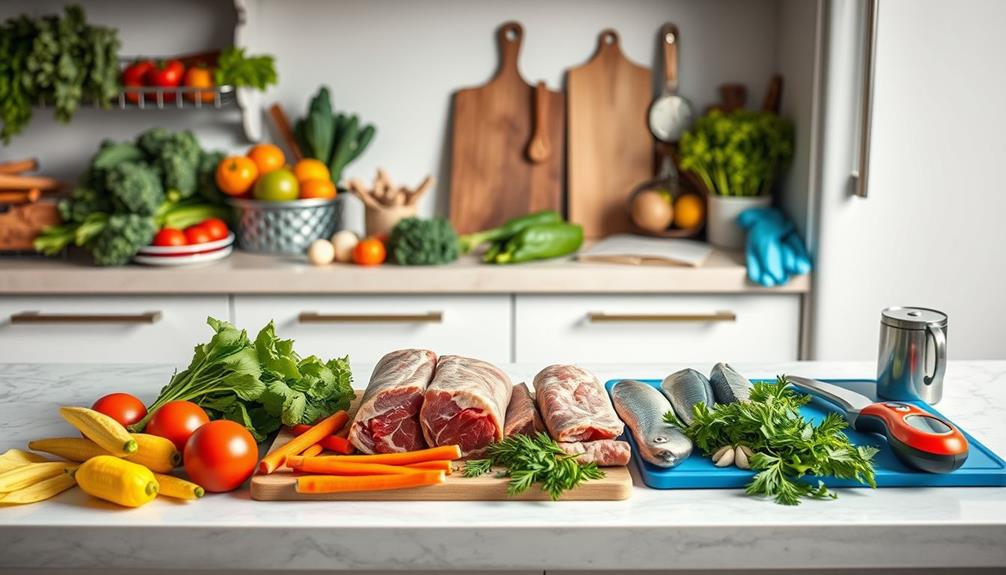
Practicing safe handling of raw dog food is essential to protect both your pet and your family from harmful bacteria. First, always wash your hands with soap and water for at least 20 seconds after handling raw pet food diets to prevent the spread of germs like Salmonella and Listeria.
Next, make sure to clean and disinfect all surfaces, utensils, and cutting boards that come into contact with raw food. This minimizes contamination risks considerably.
When you're storing raw pet food, keep it in the freezer until you're ready to use it. Thaw it safely in the refrigerator or microwave to limit bacterial growth.
It's also vital to use separate dishes and cutting boards exclusively for raw food. This practice helps avoid cross-contamination with other food items in your kitchen.
If you have any leftovers, promptly refrigerate them to prevent the growth of harmful bacteria. Make sure to use or discard any leftover raw food safely.
Benefits of Raw Feeding
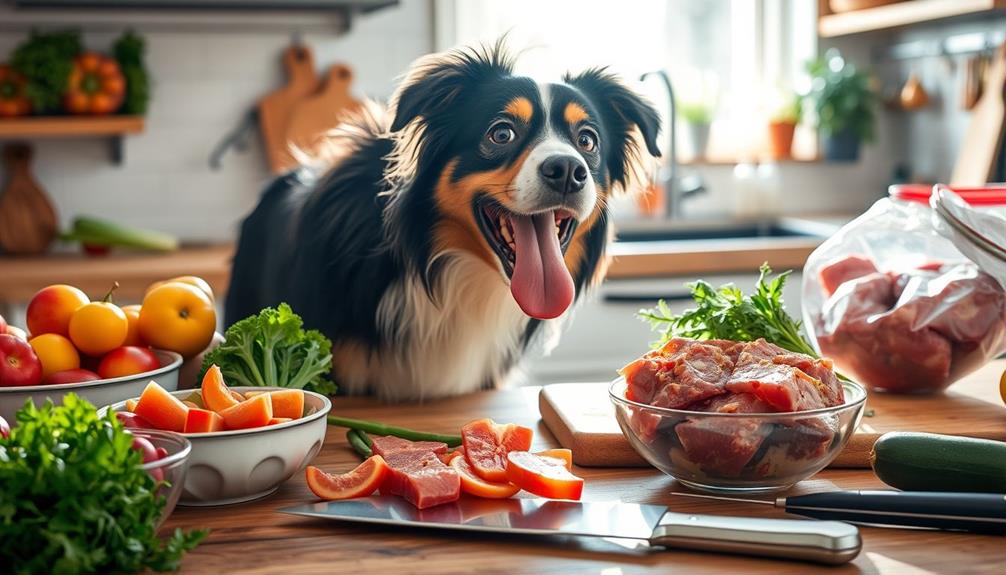
Many dog owners are finding that raw feeding offers a range of benefits for their pets. Advocates of raw diets often highlight the advantages of nutrient density and higher fat content found in raw meat, leading to a shinier coat and healthier skin.
You might even notice increased energy levels and overall vigor in your dog, as raw feeding mimics their ancestral eating patterns.
Here are a few emotional benefits you might experience:
- Your dog may enjoy improved dental health from chewing on raw bones, reducing plaque and tartar buildup.
- You could appreciate the sight of smaller stool sizes, suggesting better digestion and nutrient absorption.
- Managing food allergies becomes easier with limited ingredient raw diets, allowing you to carefully control what goes into your dog's meals.
Making Informed Feeding Choices

While the benefits of raw feeding can be appealing, making informed choices about your dog's diet is fundamental for their health and well-being. It's important to recognize the risks associated with raw food. A significant percentage of raw food samples test positive for harmful bacteria like Salmonella and Listeria monocytogenes, which can lead to foodborne illness not only in dogs but also in humans handling the food.
Consulting a veterinary nutritionist before switching diets is a must, as many raw food formulations may lack necessary nutrients. The FDA and CDC recommend avoiding raw diets, especially in households with children, the elderly, or immunocompromised individuals. Maintaining strict hygiene practices is critical when handling raw food.
Here's a table summarizing key considerations:
| Consideration | Importance | Action Required |
|---|---|---|
| Nutritional Balance | Fundamental for pet health | Consult a veterinary nutritionist |
| Bacterial Contamination | Risk of foodborne illness | Follow strict hygiene practices |
| Regular Check-Ups | Monitor health during diet change | Schedule vet visits |
| Family Safety | Protect vulnerable individuals | Avoid raw diets in certain homes |
| Dog's Reaction | Identify any gastrointestinal issues | Observe and report to vet |
Frequently Asked Questions
How Do I Make Sure Raw Food Is Safe for My Dog?
To guarantee raw food's safe for your dog, wash hands and surfaces thoroughly after handling, use separate utensils, store food properly, and consult a vet for a balanced diet. Monitor for any health issues.
What Do Vets Say About Raw Diet for Dogs?
Vets often express concern about raw diets for dogs, highlighting risks like bacterial contamination and nutritional imbalances. They recommend consulting a certified veterinary nutritionist to guarantee any diet meets your pup's health needs.
Why Is Raw Food Not Recommended for Dogs?
Why would you risk your dog's health? Raw food diets can expose them to harmful bacteria and nutritional imbalances, increasing the chance of infections and complications. Prioritizing a balanced diet is essential for your pet's well-being.
What Are the Guidelines for Raw Food Dogs?
When feeding your dog raw food, practice strict hygiene, consult a veterinary nutritionist for balanced meals, monitor for gastrointestinal upset, guarantee fresh water availability, and limit treats to 10% of their daily calories.
Conclusion
In summary, while raw food diets can offer benefits, they come with potential risks that shouldn't be ignored. It's essential to weigh the pros and cons, like balancing a tightrope, to guarantee your dog's health and safety. By understanding nutritional needs and practicing safe handling, you can make informed choices that suit your furry friend. Always consult your vet before diving into the raw feeding world—after all, your dog's well-being is the most important ingredient in this recipe.

